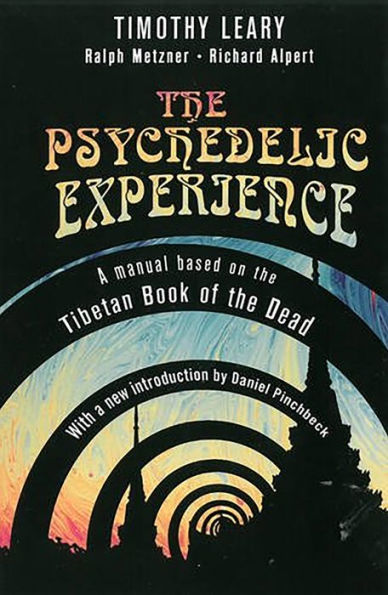
The Psychedelic Experience: A Manual Based on the Tibetan Book of the Dead
160
The Psychedelic Experience: A Manual Based on the Tibetan Book of the Dead
160Paperback
-
SHIP THIS ITEMTemporarily Out of Stock Online
-
PICK UP IN STORECheck Availability at Nearby Stores
Available within 2 business hours
Related collections and offers
Overview
The authors were engaged in a program of experiments with LSD and other psychedelic drugs at Harvard University until sensational national publicity unfairly concentrating on student interest in the drugs, led to the suspension of the experiments. Since then, the authors have continued their work without academic auspices.

Product Details
| ISBN-13: | 9780806516523 |
|---|---|
| Publisher: | Kensington |
| Publication date: | 10/28/2000 |
| Pages: | 160 |
| Product dimensions: | 5.99(w) x 8.97(h) x 0.41(d) |
About the Author
Ralph Metzner is a professor emeritus of psychology at the California Institute for Integral Studies and president of the Green Earth Foundation, a nonprofit organization dedicated to reconnecting humans and the environment. He is also well known for his decades of research and writing on the subjects of consciousness, psychedelics, the practice of yoga, meditation and shamanism.
Richard Alpert, also known as Ram Dass, is a former professor who conducted controversial LSD experiments with Timothy Leary at Harvard and Millbrook. He eventually made a philosophical split from Leary and traveled to India to study Hinduism and yoga. This transformational experience led him to write the classic spiritual text Be Here Now. Having founded a number of spiritual organizations that promote personal growth, the importance of serving others, and unity among different religious traditions, Ram Dass is considered one of the most important spiritual teachers of the 20th century.
Daniel Pinchbeck is the author of Breaking Open the Head: A Psychedelic Journey into the Heart of Contemporary Shamanism and 2012: The Return of Quetzalcoatl. His writing has appeared in The New York Times Magazine, Rolling Stone, ArtForum, and many other publications. He launched the web magazine Reality Sandwich and has written columns for Conscious Living and Dazed & Confused. In much of his recent work, he explores the profound implications of the shamanic experience and the possibility that a revival of archaic knowledge of visionary plants and psychedelic substances could accelerate a transformation of global consciousness.
Table of Contents
Introduction (2007) Daniel Pinchbeck ix
I General Introduction 1
A Tribute to W. Y. Evans-Wentz 8
A Tribute to C. G. Jung 9
A Tribute to Lama Anagarika Govinda 16
II The Tibetan Book of the Dead 21
First Bardo: The Period of Ego-Loss or Non-Game Ecstasy 23
Part 1 The primary clear light 23
Part 2 The secondary clear light 28
Second Bardo: The Period of Hallucinations 33
Introduction 33
Explanation of the Second Bardo 34
The peaceful visions-Vision 1 : The source 38
Vision 2: The internal flow of archetypal processes 38
Vision 3: The fire-flow of internal unit 42
Vision 4: The wave-vibration structure of external forms 45
Vision 5: The vibratory waves of external unity 48
Vision 6: "The retinal circus" 50
Vision 7: "The magic theatre" 52
The wrathful visions 54
Conclusion of Second Bardo 56
Third Bardo; The Period of Re-Entry 58
Introduction 58
General description of the Third Bardo 59
Re-entry visions 63
The all-determining influence of thought 65
The judgment vision 67
Sexual visions 69
Methods for preventing the re-entry 71
Method of choosing the post-session personality 72
General Conclusion 74
III Some Technical Comments About Psychedelic Sessions 77
Use of this manual 79
Planning a session 80
Drugs and dosages 82
Preparation 84
Setting 87
The psychedelic guide 89
Composition of the group 92
Follow-up 93
IV Instructions for use during a Psychedelic Session 95
First Bardo Instruction 97
Second Bardo Preliminary Instructions 100
Instructions for Vision 102
Instructions for Physical Symptoms 103
Instructions for Vision 2 104
Instructions for Vision 3 105
Instructions for Vision 4 106
Instructions for Vision 5 107
Instructions for Vision 6 108
Instructions for Vision 7 109
Instructions for the wrathful visions 110
Third Bardo Preliminary Instructions 111
Instructions for the re-entry visions 115
Instructions for the influence of thought 116
Instructions for the judgment vision 117
Instruction for the sexual vision 119
Four methods of preventing re-entry 120
Meditation on the Buddha 120
Concentration on good games 121
Meditation on illusion 122
Meditation on the void 123
Instructions for choosing the post-session personality 124
